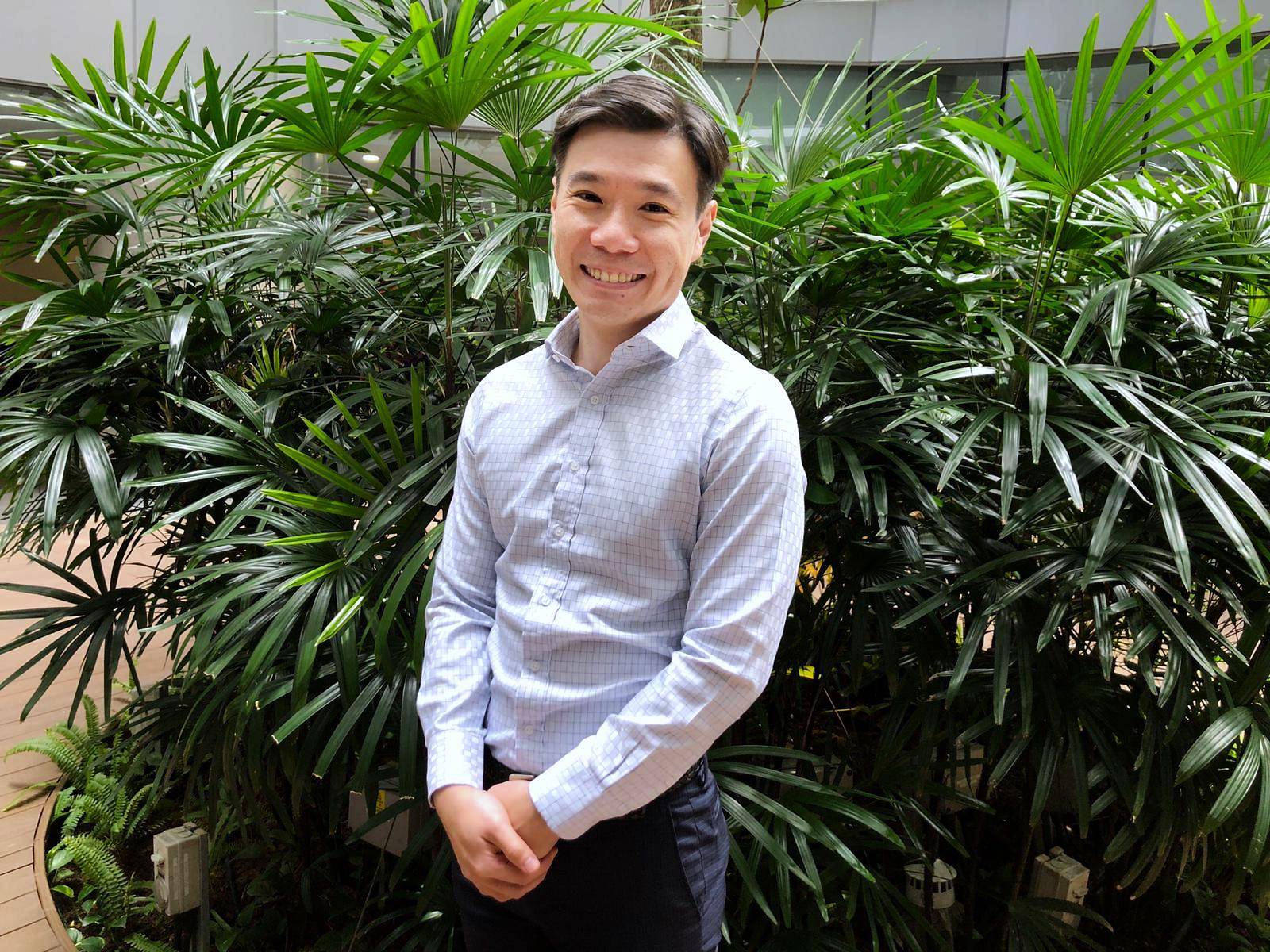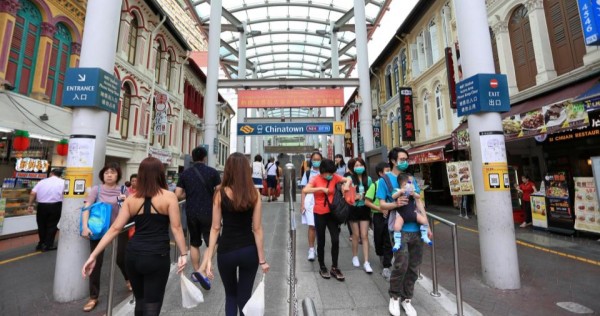SINGAPORE: It was a walk to remember.
On Friday (Oct 16), CNA journalists Matthew Mohan and Gaya Chandramohan completed their long journey around Singapore, which saw them clock 140km over the space of five days. They kicked off their walk at 6am on Monday from Taman Jurong Market and Food Centre and returned there at 2pm on Friday.
Their goal?
To rediscover the parts of the island that they had otherwise forgotten about and uncover new hidden treasures, some of which people might not know about.
After all, with limited opportunities for overseas travel because of COVID-19, discovering what is on your doorstep is the next best thing.
This is Matthew Mohan’s account of the five-day journey.

MONDAY: TAMAN JURONG HAWKER CENTRE – JURONG LAKE GARDENS – KENT RIDGE PARK – HORT PARK – HARBOURFRONT
The journey began in a slightly inauspicious way.
I had set my heart on kicking off this long walk around Singapore by slurping down a delicious bowl of lor mee at Taman Jurong Market and Food Centre. Alas, the stall which I had hoped to get it from is closed on Mondays.
CNA journalist Matthew Mohan begins the marathon walk around Singapore, Oct 12, 2020. (Photo: Gaya Chandramohan)
READ: As it happens: CNA explores Singapore on foot Day 2
So breakfast would have to wait – but our walk couldn’t.
With more than 100km ahead of us, we set off with fire in our bellies rather than food towards the first stop – Jurong Lake Gardens. We’d heard a lot about the park from readers as well as friends and it did not disappoint.
Early morning at Jurong Lake Gardens. (Photo: Matthew Mohan)
After a short trek, the shimmering beauty of Jurong Lake came into view, reflecting images of civilisation in the distance. We might have been in the middle of a massive housing estate, but here was an oasis of calm and tranquility.
Breezing past joggers and cyclists, we made our way towards the southern half of the park where we were greeted by an expanse of rustling grass and patches of lalang. Jutting out from the landscape was a lone tree – a sculpture made from recycled iron bars, which we later found out was an ode to the industrial origins of Jurong.
Even the grey, overcast sky couldn’t do much to spoil the beauty of the area. In fact, quite the opposite. The bare branches of the sculpture somehow fitted in perfectly with the low, scudding clouds – much more so than if we’d been walking through typical, tropical sunshine.
The Lone Tree at Jurong Lake Gardens. (Photo: Matthew Mohan)
Perched on a grass mound, we drank the view in. Apart from a couple posing for what looked to be their wedding photoshoot pictures, we had the area to ourselves.
Bliss.
With the Chinese and Japanese Gardens both closed for maintenance, we had to walk a loop of Jurong Lake Gardens rather than taking a shortcut. This added distance was something we’d dreaded while planning the route, but with the sun showing no sign of peeking through the thick cloud cover anytime soon, things were easier than anticipated.
Rounding a bend, we were greeting by the sight of otters frolicking on a deck, completely oblivious to their surroundings. We succumbed to the temptation to snap a quick video of the furry critters and ended up spending a little more time at the park than expected.
A couple taking wedding pictures at Jurong Lake Gardens. (Photo: Matthew Mohan)
We pushed on in the direction of West Coast, along a road which threw up various memories of our childhood. First, a smiling snowman marking a familar haunt in the form of Snow City, and then the various exhibits sitting idle outside Science Centre – a reminder of field trips and school lessons.
It had indeed been a while.
Further down the road loomed a strange asymmetrical building. It had a clock tower resembling a periscope, a body representing a ship and a look unlike anything I’d seen before. This was Jurong Town Hall, a building gazetted as a national monument in 2015.
I could see why.
Its architecture was eye-catching. When it was gazetted in 2015, the National Heritage Board described it as “an iconic testimony to Singapore’s drive towards modernisation and development in its early years of independence”. Gazing at its angular, 1970s lines, such a description seemed entirely apt.
Jurong Town Hall looms in the distance. (Photo: Matthew Mohan)
We had planned for Teban Gardens Hawker Centre to be the first food stop along the first leg of our walk, but with options there seemingly limited, we decided to tackle a section of Pandan Reservoir on the way to Ayer Rajah Food Centre.
Indian Rojak probably isn’t supposed to be type of light meal one’d enjoy while on a long trek, but I enjoyed every mouthful.
In my opinion one of the best versions of the dish anywhere on the island, Abdhus Salam Rojak is always a must-stop when I visit the hawker centre. As I dunked pieces of deep-fried goodness in bowls of crunchy gravy, it more than hit the spot.
A hearty meal of Indian rojak at Ayer Rajah Food Centre. (Photo: Matthew Mohan)
With about 15km under our belts, the sun slowly started to make sporadic appearances as we followed the long stretch of West Coast Road.
It was here the muscles began to tighten, and the straps on our backpacks began to weigh down just that little bit more. But with the quay cranes of the port beckoning, it looked like our end-point of Harbourfront wasn’t that far away.
But we were wrong.
Trudging underneath a flyover near Teban Gardens. (Photo: Gaya Chandramohan)
With West Coast Park done and dusted, it should have been a straight shot to our hotel – about 6km, a distance which shouldn’t have taken that long to cover.
But in a ridiculous moment of ambition, I figured that it might be worth taking a detour up to Kent Ridge Park. The idea was to cut through these parks, taking a course parallel to West Coast Highway – which to all intents and purposes, was a yawn of a road.
With Gaya convinced, we weaved a path up Pepys Road and within 15 minutes, we knew we had made a mistake. The steep incline of the road meant the going was tough and this took valuable time off what we had on our hands.
Talking a walk through Hort Park. (Photo: Matthew Mohan)
Slowly beginning to pant, we criss-crossed our wayfrom Kent Ridge Park through to Hort Park, which had a number of interesting stops, but the distance was beginning to take a toll. We’d covered about 25km at this point.
Despite starting to feel tired, the appeal of Hort Park revived our energy. Boasting myriad gardens, greenhouses and the odd trail, it was a pleasant surprise to see what this lesser-known park had in store. Carefully cultivated with plenty of hidden delights, it deserved more time than we could spare.
And those time constraints meant we had to give the Southern Ridges and Henderson Waves a miss – spots that are extremely popular. Never mind – we could come back another day.
A “play mosaic” of the iconic dragon playground is located at Hort Park. (Photo: Matthew Mohan)
Eventually managing to navigate our way back to the main road – this took some trouble believe me – we set out on our final stretch of road.
As the sirens were to a lonely sailor, MRT stations along the way formed fleeting temptations as we trudged along.
But the sight of the hulking shopping mall Vivocity across the road and the beautiful, mesmerising cable cars in the skyline above meant that we’d reached our endpoint for the day.
11 hours and 30km later, our first leg was complete.
Cable cars in the distance. (Photo: Matthew Mohan)
We’d discovered a new park, enjoyed a hearty meal of one of Singapore’s best dishes, and seen an iconic building.
Day one complete, four more to go.
DAY TWO: HARBOURFRONT – CHINATOWN DISTRICT – HONG LIM MARKET – EAST COAST PARK – SINGAPORE EXPO
“This char kway teow is too wet,” remarked a regular at Hong Lim Market and Food Centre, an empty red plate streaked with stains of a meal consumed resting in front of him.
Having probably just had the best meal of a trip around Singapore, I was incredulous.
“But, it’s usually like that. Their version is not bad, and tastes good. I used to come here two to three times a week,” clarified 62-year-old Mr Lee, who only wanted to be known by his last name.
“I come to this hawker centre only for this char kway teow, nothing else.”
Mouthwatering char kway teow. (Photo: Matthew Mohan)
It was easy to understand why – the noodles were the right blend of spicy, sweet and savoury. Accentuated by the crunch of the beansprouts, crispness of lard and the smoothness of the cockles, this had to be one of Singapore’s best versions of the dish.
I had tried Outram Park Fried Kway Teow Mee on a number of occasions in the past, and as we made a beeline up the stairs to the second floor of the food centre, I was bracing myself for a wait.
READ: CNA explores Singapore on foot (Day 1): The lone tree and the longer-than-expected walk
After all, this char kway teow usually comes served with a 30 minute wait.
But to my utter amazement, there was nobody in line. Fried, dished, served. I scoffed down my meal in less than 15 minutes.
“I had already been patronising this stall since it was at Outram,” explained Mr Lee. “After it shifted, I couldn’t locate it for a few years. I would give it 9/10, no problem. But I can’t give it full marks, full marks would be 100 per cent!”
Shophouses en route to Hong Lim Market and Food Centre. (Photo: Matthew Mohan)
Who was I to argue?
BLAST FROM THE PAST
It had been a rather uneventful walk to Hong Lim Market and Food Centre. Fresh out of the hotel, and with less than 30 minutes on the clock, we were met by the blaring horn of a car that sped by just inches away from us.
A mural in Chinatown by Yip Yew Chong. (Photo: Gaya Chandramohan)
In our early morning stupor, my colleague Gaya Chandramohan and I had mistaken the flashing green man across the street for our own go-ahead to cross. Big mistake.
We were nearly clipped by a driver who was alert enough to sound the horn at two tired journalists who had clearly walked a bit too much the day before.
With that sobering incident not too far from both our thoughts, we spent the rest of the day being extra cautious at stop signs and traffic lights. Better safe than sorry.
A mural along Neil Road. (Photo: Gaya Chandramohan)
Today’s 28km route was to begin at Harbourfront, where we’d spent the night at a hotel, and end at Expo, where we’d also put up for the night. Despite the 30km we clocked the day before, we felt surprisingly sprightly. After some stretching the night before, the nagging aches had worn off.
READ: 110km, five days, two reporters: CNA sets out to explore Singapore on foot
We weaved our way quickly through the Chinatown and Tanjong Pagar district, enjoying the brightly coloured and lovingly restored shophouses. Further down our route, visual feasts awaited us along the South Bridge Road – the Buddha Tooth Relic Temple, Sri Mariamman Temple and Jamae Chulia are reminders of the religious diversity of the country we live in. And all of them were looking splendid.
There were also elements of the past along the way, from an old payphone along Neil Road – we could still somehow place a call – to Yip Yew Chong’s mural in a quiet alleyway off Smith Street, a beautiful scene packed with stunning details from Yip’s childhood.
These were legacies of different eras from those we were born in, but we appreciated them just as much.
Being able to explore these places on a weekday and in the early hours of the morning added a different dimension to things – we could move at our own pace, away from the crowds and slowly savour what these districts had to offer.
Facing the sun outside the National Gallery Singapore. (Photo: Gaya Chandramohan)
Having ticked off Parliament House, the National Gallery Singapore and St Andrew’s Cathedral from our list of mandatory landmarks, we charged up Benjamin Sheares Bridge.
And there, in stunning glory, was a mighty view.
Gardens by the Bay, the Singapore Flyer and Marina Bay Sands stood proudly across the water. These monuments to Singapore’s modernity make for an eye-catching vista, and were a sharp contrast to the historic districts we had been strolling through in the morning.
Taking a photo at Benjamin Sheares bridge. (Photo: Gaya Chandramohan)
The last time I’d had this view while on foot was while I was a National Service recruit, many moons ago. It was in the middle of the night – I was in green, sweating, and marching.
Funny how life has a way of bringing one full circle.
A jogger on the Singapore Formula One Grand Prix track (Photo: Matthew Mohan)
PAIN BEFORE PLEASURE
The toughest part of our journey on Tuesday was probably the long stretch of East Coast Park. A seemingly benign patch of green on the map, it was anything but.
As the sun began to blaze down and cyclists began to whiz past us, we realised why we were probably the only ones foolhardy to tame the stretch on foot.
And yet, even as the sun beat down and our legs became heavier, there were still moments of pleasure.
Envisioning the pain that awaited at East Coast Park. (Photo: Gaya Chandramohan)
The sound of the gentle waves lapping on the beach, the occasional cries of delight from a toddler enjoying an afternoon playing in the sand and the occasional slice of cool shade from the trees along the route were reminders that this is one of Singapore’s favourite playgrounds.
And on a Tuesday afternoon, free of the weekend crowds who flock to the area, it was more enjoyable and peaceful than I’m used to.
We gradually came across more signs of civilisation, but also reminders of a pandemic – benches cordoned in bright orange tape a reminder of the times we’re in.
Slices of watermelon were our sustenance. (Photo: Matthew Mohan)
And we pressed on, cooled down by slices of watermelon that a friend had kindly prepared as she met us halfway during the walk with her two boys.
This tided us over to our last stop before making the trek to the Expo – East Coast Lagoon Food Village. We’d heard of mouthwatering carrot cake and excellent satay from readers keen to share their foodie tips with us.
But we were there at 3pm.
We settled for cold gulps of sugarcane juice and some admittedly excellent barbecue chicken wings. An oyster omelette stall that I’d been hearing rave reviews about also happened to open its doors just as we were about to leave.
A faint breeze at East Coast Park. (Photo: Matthew Mohan)
I dug in. It was no 9/10 char kway teow and but it would have to do.
After all as we’ve been finding out every day along this trek, you win some, you lose some.
DAY THREE: SINGAPORE EXPO – PASIR RIS PARK – CONEY ISLAND – ROWERS BAY
We’d dawdled over lunch. After all, this was the first chance to get solid food in our bellies since the previous day’s dinner.
Over plates of luscious white beehoon, my colleague Gaya Chandramohan and I discussed the day’s developments.
Zoe Tay walking through Pasir Ris Park with CNA journalists Matthew Mohan Gaya Chandramohan on Day 3 of the Singapore on Foot expedition. (Photo: Jeremy Long)
There had been the surreal walk with actress Zoe Tay to start the day, a tranquil stroll through the towering casuarina trees of Coney Island, and the unexpected encounters with readers who recognised us en route.
As our aching muscles nagged their disapproval, we had to wrench ourselves away from the air-conditioned comfort of the restaurant and face the baking sun. Our final 7km of the day awaited.
But we had scarcely walked more than 500m when we were met with a plastic bag straining with cold drinks.
READ: As it happens: CNA explores Singapore on Foot Day 4
A sumptuous plate of white bee hoon. (Photo: Matthew Mohan)
Our refreshments came courtesy of CNA readers Sherlyn Lee and Foo Siang Hwee, who had been following our journey on Twitter and drove down from their home in Punggol. They’d patiently waited while we were scoffing down our food so as to not disturb us.
And here they were, with drinks in hand. Our stomachs were full, but our hearts fuller.
CNA readers Foo Siang Hwee (extreme left) and Sherlyn Lee with journalists Matthew Mohan and Gaya Chandramohan. (Photo: Foo Siang Hwee)
A SURPRISE GUEST
Wednesday had been a day full of surprises.
Our route was due to take us from Singapore Expo to Pasir Ris park, then north to Coney Island, before taking a coastal loop that would see us end the day on the edge of Yishun Dam.
We’d started off the day feeling a little nervous – and it wasn’t because of the road ahead of us.
Actress Zoe Tay and CNA journalist Matthew Mohan walking through the Expo area on Day 3 of the Singapore on Foot expedition. (Photo: Gaya Chandramohan)
Zoe Tay had been following our exploits on social media and had reached out to us to check if she could join us for a portion of the journey. We had to double check if those messages were real – they were.
And so we walked, making quick work of our early morning start. The nervousness slowly ebbed away, as we breezed through conversation topics.
We learnt about how Zoe started walking regularly during the COVID-19 pandemic, what life was like when she grew up in Lim Chu Kang (an area which we will cover in the last leg of our trek), and her love for dogs.
Zoe Tay walking through Simei with CNA journalists Matthew Mohan and Gaya Chandramohan. (Photo: Jeremy Long)
One question we had to ask was whether the current rule about wearing a mask means that she is less recognised in public at the moment.
Yes indeed, she said. Most people don’t realise it’s her.
As we rounded the corner to Pasir Ris park, clouds began to gather on the horizon. After a momentary distraction in the form of two gorgeous striped Bengal cats and their affable owner, we sought shelter under a nearby pavilion.
“Are you guys from CNA?” came the question. Here we were with a major celebrity like Zoe Tay, but we were the ones being recognised! Was this what stardom feels like? Of course, we eventually told them who our walking companion for the day was – to their utter delight.
Zoe Tay pets a Bengal cat at Pasir Ris Park. (Photo: Jeremy Long)
There were several other surprises along the way – those of the feathered, scaly and furry kinds.
There were the squawking herons in Pasir Ris Park, the lone wild boar at serene Lorong Halus wetland and the monstrous monitor lizard close to Coney Island. Wildlife seemed to spring up at every corner and we were enjoying every second of it.
A pet Bengal cat at East Coast Park. (Photo: Gaya Chandramohan)
Lorong Halus wetland was an unexpected delight. A ten minute walk from the entrance to Coney Island, we had stumbled across the park entirely by chance.
Located on the site of a former landfill, the man-made wetland is located adjacent to the recognisable Lorong Halus bridge. The bridge is one of the more famous photo spots in the area and links the area to nearby Punggol.
The wetland itself would prove the perfect place for a quick break, as we chugged mineral water and enjoyed the views of the rustling weeds and placid ponds that dotted the landscape.
The Lorong Halus red bridge. (Photo: Matthew Mohan)
After trudging through some areas of urban sprawl on the first two days of our journey, we were now seeing a very different side of Singapore. This was a reminder that even though we live in a city-state, nature has been carefully preserved as much as possible.
At the entrance to Coney Island, we met another reader who had been following our journey on Twitter. He had taken a brief stop during an epic 80km bike ride, following a loop from Woodlands.
The serene Lorong Halus wetland. (Photo: Matthew Mohan)
His was a one-day sprint, and ours a five-day marathon. But there were similarities in the spirit of adventure, in the desire to explore and embrace what Singapore has to offer.
On a quiet bridge leading to Coney Island, we had found a kindred spirit.
Journalist Matthew Mohan exploring Coney Island. (Photo: Gaya Chandramohan)
DAY FOUR: ROWERS BAY – SEMBAWANG HOT SPRINGS – SUNGEI BULOH WETLAND RESERVE – KRANJI COUNTRYSIDE
The morning of his 38th birthday found Mr Lim Zi Yuan barefoot and with a newly purchased red bucket by his side.
“We did Lazarus Island and Kusu (Island) on Tuesday, we went to Coney Island yesterday … so it’s really end-to-end of Singapore,” said Mr Lim, when I asked him why he and his wife had decided to drive down to Sembawang Hot Spring Park from his home in Farrer Park.
“We thought we would come at this odd hour, when it was warmer but we were caught by surprise by the number of people.”
Mr Lim Zi Yuan and Ms Ng Pei Yin pose for a photograph. (Photo: Matthew Mohan)
He wasn’t the only one who was surprised.
Our penultimate day of walking around the island had seen us reach the hot springs at about 10am. And what would be more rewarding than soaking our battered, blistered and bruised feet in the steaming water of the hot spring?
READ: Sembawang Hot Spring Park reopens with cascading pool, cafe and floral walk
Well, we had to get in line first. It might have been the middle of the morning on a weekday, but the chatter of conversation that emanated from within the park as we entered was a clear sign that we wouldn’t be alone.
Having reopened earlier this year, the 1.1-hectare park is clearly a hit, with the cascading pool the most popular spot in the park. Water cools naturally as it flows down a four-tiered pool, starting at 70 degrees Celsius at the top and reaching the bottom at 40 degrees Celsius.
The cascading pool at Sembawang hot springs park. (Photo: Gaya Chandramohan)
I had to bide my time though, before being able to slide into a spot on the perimeter of the pool.
Bliss. Well, first some pain as I nearly scalded my feet – but soon after, that – bliss.
The park is another example of a (somewhat) hidden gem lurking in Singapore, which perhaps many people have yet to experience. If you want to try something different, it’s well worth it.
THE NEVER-ENDING ROAD
We’d begun the day at Rowers’ Bay, yet another park that we’d discovered only because of our journey. Nestled right at the edge of Yishun Dam, the park at Lower Seletar Reservoir is named for the reservoir’s popularity with kayaking and dragon-boating enthusiasts.
As we crossed Yishun Dam with the wind at our backs, we kept our eyes peeling, hoping to spot monitor lizards and other wildlife on the banks of the river. It took us less than fifteen minutes to cross the dam and the same amount of time to spot a monitor lizard casually poking its head through a thick of reeds by the shore.
First came the pleasure, but next was the pain. We had a stretch of about 15km that awaited us between the hot springs and our next major pitstop – Sungei Buloh wetlands reserve.
We’d mentally geared ourselves up for this one. There would be little to see, but much to walk. As we ticked off MRT stations on the North-South line, things seemed to be going well.
But as the sun blazed and our muscles ached, the walk became a trudge. We started to see a change in the landscape as HDB blocks slowly disappearing into the distance, and in their place sprung up construction sites.
A stretch of road near Kranji Reservoir Park. (Photo: Matthew Mohan)
We passed dormitories and factories, excavators and lorries – a side of Singapore seldom seen and usually forgotten.
And yet, even as the heat and monotony threatened to take their toll, my mind started to wander. All these factories and industrial facilities have a tale to tell, and I couldn’t help thinking of what they show about Singapore’s history.
For instance, there were construction companies which looked like they had been around for decades, and which must have played a part in Singapore’s development since independence. So too the workers toiling in the sun, their efforts often overlooked.
I wouldn’t necessarily recommend visiting the area, but I quite enjoyed seeing a part of Singapore very far removed from the sparkling modern metropolis of the CBD or some of the nature spots we had experienced earlier in the walk.
READ: CNA explores Singapore on foot (Day 3): The generosity of strangers and walking with a star
Dragging ourselves past the tranquil Kranji Reservoir Park, in the distance we caught sight of Sungei Buloh Wetland Reserve.
Some respite finally beckoned.
Along Sungei Buloh wetland reserve’s coastal trail. (Photo: Gaya Chandramohan)
MANGROVES AND MUDFLATS
My last visit to the reserve had been when it was still known as Sungei Buloh Nature Reserve – it was renamed in 2002. It had been some time.
So I was pleasantly surprised as we strolled through the park, there were new trails, new boardwalks and new rest-stops.
We embarked on the park’s coastal trail, taking a route which skirted its edge, bringing us face to face with an impressive network of mangroves. The call of migratory birds and the buzz of cicadas punctuated the silence as we eyed every log-like object, hoping to chance upon one of the park’s resident crocodiles.
With time tight – we still had to walk to our accommodation for the night in Lim Chu Kang – we decided to give our croc hunt one last go, and follow the park’s mangrove boardwalk.
A hornbill at Sungei Buloh wetland reserve. (Photo: Gaya Chandramohan)
Still no dice. But just as we were about to leave, we came across probably our best sighting of the day – a pair of hornbills peering inquisitively down from the foliage at us.
As we had so often learnt during our trek around the island, sometimes the best surprises come when one least expects it.
DAY FIVE: KRANJI COUNTRYSIDE – BOLLYWOOD VEGGIES – NEO TIEW ESTATE – LIM CHU KANG – TAMAN JURONG HAWKER CENTRE
My eyes had just about adjusted to the sunlight filtering through the curtains at my room in the Lim Chu Kang resprt when the phone started buzzing.
“No Caller ID” read the screen – surely this was too early in the morning for a scammer pretending to be an official from China?
“Hi Matthew, this is Zoe Tay. Have you guys started your walk today yet?” came a familiar voice. “I’m here outside. Hope I haven’t missed you guys yet!”
The entrance to our accomodation for the night at Lim Chu Kang. (Photo: Matthew Mohan)
It was the morning of the fifth and final day of our expedition and actress Zoe Tay was surprising us with bread and the offer to be our walking companion again.
Just as we had started to become addicted to our long exploration of Singapore, so it seemed that Zoe also wanted more of this experience. Hence, the unexpected early morning call.
I had to pinch myself to make sure this was real.
Walking through Bollywood Veggies with Zoe Tay. (Photo: Gaya Chandramohan)
FUN IN THE COUNTRYSIDE
We had mixed feelings before the start of the last day of our marathon walk around Singapore.
On the one hand, we were looking forward to completing the journey and enjoying a long rest. On the other, the route for the day would take us through Lim Chu Kang road and Jalan Bahar, areas which my colleague Gaya Chandrmohan and I only knew to contain cemeteries and army camps.
There would be hardly any pedestrianised walkways, and with trucks hurtling up and down along the two-lane road weaving through the Kranji countryside, we were unsure whether the area would hold much appeal.
Zoe Tay pointing out where the coffee shops and market used to be when she lived along Lim Chu Kang Road as a teenager. (Photo: Gaya Chandramohan)
So Zoe’s arrival gave us a welcome boost. Having grown up in Lim Chu Kang, this was an area she was more than familiar with. She proved to be the perfect guide.
And so, what would have probably seemed like overgrown jungle to us took on so much more significance as she patiently pointed to areas she was familiar with from her childhood and how they used to look.
There was the shop in which she permed her hair for the first time and then regretted how it turned out. There was the community centre where she was given her BCG injection and the nurse was so rough that it led to her fear of needles. There was one of the first HDB blocks in the area, where she played on the playground slide and got too tanned.
The countryside had come alive.
A path in the Kranji countryside. (Photo: Matthew Mohan)
Instead of long stretches of anonymous undergrowth and bland roads, Gaya and I were now seeing into Singapore’s past. For sure, this area has changed – like so much of the country – and learning a little of its history was a joy.
En route to the area of Zoe’s old home, we visited Bollywood Veggies, a sprawling farm nestled in the Kranji countryside. We had the pleasure of a short guided tour in the one of the compound’s gardens and I even had a go at harvesting rice – thoroughly enjoyable.
Despite the farm’s far-flung location, it was already seeing excited guests come through its gates as early as 9am in the morning, eager to explore the compound or enjoy breakfast at the farm’s bistro.
Leaving the farm with a belly full of banana bread, I made a mental note to return. Now if only there were a public bus service plying this route rather than the sole shuttle service!
Stopping along an old bus stop at Lim Chu Kang road. (Photo: Matthew Mohan)
With Zoe bidding farewell to us after about three hours on the road, it was left for us to conquer the remaining kilometres – ending our journey just as we started off.
This proved to be easier said than done under the fierce heat of the midday sun. We’d foolishly neglected to purchase water when we’d set off and the back of our throats were beginning to dry up.
When a petrol station finally materialised in the distance, we couldn’t get there fast enough.
A FINAL FLOURISH
After some resting, drinking and stretching, we were once again back on the road, with all eyes on the finish line.
CNA journalists Matthew Mohan and Gaya Chandramohan walking through Jalan Boon Lay on Day 5 of the Singapore on Foot expedition. (Photo: Jeremy Long)
This was the moment that we had been thinking of for some time now, and as the signboard for Taman Jurong Market and Food Centre came into view, we couldn’t help but break into smiles under our sweat soaked face masks.
It had been a journey that had seen us clock a distance we wouldn’t otherwise have walked (140km instead of the originally planned 110km), seen us explore parts of Singapore that we’d otherwise never had chanced upon and meet people that we’d never otherwise have met.
The island had proven to offer so much and then some more. From the swaying lalang fields of Jurong Lake Gardens to the waterlogged mangroves of Sungei Buloh, we’d had an adventure that we and our aching bodies wouldn’t be forgetting any time soon.
We’d done it. But there was one more task left unfinished.
CNA journalists Matthew Mohan and Gaya Chandramohan walking through Jalan Boon Lay on Day 5 of the Singapore on Foot expedition. (Photo: Jeremy Long)
I trudged up the escalator with my backpack in search of that elusive bowl of lor mee that I had wanted for breakfast on the first day. And just as I had made my way to the stall in question, I noticed the hawkers packing up for the day.
My lor mee would have to wait – perhaps until the next round island trek.
FINAL THOUGHTS
Prior to this walk, domestic travel and exploration had never really been of much interest to me.
There were the tried and tested destinations like the Singapore Zoo, Marina Bay Sands and East Coast Park which I had enjoyed, but was there truly anything more out there?
After all, how much variety in experiences could one enjoy within such a small space?
But our journey across Singapore emphatically answered that question – there is indeed plenty to do, and quite a lot to learn.
As unglamorous as it seems, we made sure to stretch at every opportunity we got. (Photo: Gaya Chandramohan)
Going about the journey on foot also meant that we took the time to really appreciate our surroundings. What would have been a five minute journey via car would translate to a thirty minute walk – and painful though that may have been at times, it added an extra dimension to our adventure.
And even though our bodies are sore and legs are weary, both of us will always look back on this journey with lasting memories.
Now, its time for you to make your own.










